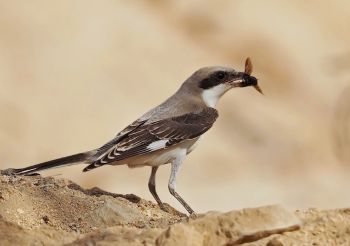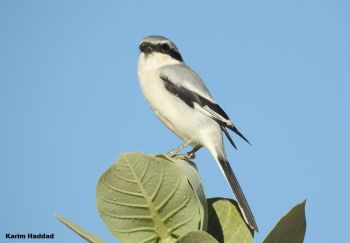- Lanius excubitor
Includes Steppe Grey Shrike
Identification
Length 22-26 cm (8½-10¼ in), weight 50-80 g
Adult
- Grey head and back
- White belly, throat, flanks and chest (flanks often faintly barred pale grey in females)
- Black wings with white patch at base of primaries
- Medium-long tail, black with white outer feathers
- Black mask on face extending to base of bill, but not over top of bill
- Distinctive stout, hooked black bill
Juvenile
- Similar to adult except duller and faintly barred, with dark grey where adult black, and slight pinkish base to bill.
Variation
Populations differ in color of both upper- and underside, extent of white on scapulars, wings and tail, size and shape of black mask and bill, and in presence vs absence of and if present in color of supercilium. See more in the taxonomy section.
Similar species
In Europe, Iberian Grey Shrike and Lesser Grey Shrike are potential confusion species, and in north-central Asia, could overlap with Northern Shrike.
Distribution
Europe, Africa and Asia.
Breeds in most of Europe except the Iberian Peninsula but including Canary Islands, Gran Canaria, Lanzarote, Tenerife
Northern Africa: Morocco, Algeria, Tunisia, Libya, Egypt
Western Africa: Mauritania, Senegal, The Gambia, Mali, Burkina Faso, Nigeria, Niger, Chad, Cameroon
Eastern Africa: Sudan, Eritrea, Ethiopia, Djibouti, Somalia
Middle East: Turkey, Syria, Lebanon, Israel, Jordan, Saudi Arabia, Yemen, Socotra, Oman, United Arab Emirates, Kuwait, Iraq, Iran, Armenia, Azerbaijan, Georgia
Asia: Kazakhstan, Uzbekistan, Turkmenistan, Tajikistan, Mongolia, northwesternmost China, northern Pakistan, northwestern India
Taxonomy
Complex, and potentially liable to further revision[2]. A large number of subspecies were split as Southern Grey Shrike. One subspecies was left there but renamed to Iberian Grey Shrike, but most were returned to Great Grey Shrike for now. Populations from northeastern Asia and North America formerly included here have recently been split as Northern Shrike[1, 2]. Whether more splits are coming is an open question.
Subspecies

Photo © by IanF
Coatham Wood, Longnewton, County Durham, UK, 1 February 2012
Clements recognizes these 12 subspecies[1] (however, notice that not all resources agree on which subspecies are valid):
- L. e. excubitor
-
- Small white patch at base of primaries; minimal white above black mask
- L. e. homeyeri
- Balkan Peninsula to southern Ural Mountains and western Siberia
- Large white patch at base of primaries; broader white band above black mask; overall slightly paler than L. e. excubitor
- L. e. leucopterus:
- West Siberia to Yenisey River
- Similar enough to homeyeri that some authorities treat it as a synonym thereof
- L. e. koenigi:
-
- Upperparts dark grey, underparts light grey; similar to L. m. algeriensis but slightly smaller
- L. e. algeriensis:
-
- Upperparts dark grey, underparts light grey
- L. e. elegans:
- North Sahara (Mauritania to Sinai Peninsula and Red Sea)
- Upperparts light grey, underparts white
- L. e. leucopygos:
- Southern Sahara and Sahel from Mauritania to western and central Sudan
- Upperparts very light grey, rump and underparts white
- L. e. aucheri:
- Eastern Sudan south to northern Somalia; southern Lebanon, Israel, Jordan, and Arabian Peninsula east to Iran
- Upperparts mid grey, underparts white
- L. e. buryi:
- '*Yemen; vagrant to Djibouti and Ethiopia
- Darkest subspecies; very dark grey mantle, dusky grey below, supercilium and scapulars grey, not white
- L. e. uncinatus:
-
- Similar to L. m. aucheri but with less white on scapulars, and slightly longer bill
- L. e. pallidirostris:
- Breeds from southwestern Russia and northeastern Iran east to southern Mongolia, western China, southeastern Afghanistan, and southwestern Pakistan; partially migratory, south of northeastern Africa (to Sudan, northwestern Somalia), the Arabian Peninsula, and northwestern India
- Upperparts light grey, rump and underparts white; extensive white in wings; black mask narrow; bill often pale-based even in some adults (though black in many adults)
- L. e. lahtora:
- East Pakistan and northern India
- Upperparts mid grey, underparts white; similar to L. m. aucheri but more extensive white on secondary tips, and black mask extends across top of bill
A couple of these have common names attached to them: L. e. pallidirostris is Steppe Grey Shrike, and L. e. lahtora is Indian Grey Shrike. Steppe Grey Shrike has been split as a full species in the past and may become one again.
Habitat
Open areas with sparse and low vegetation including bogs with scattered trees, bushes and other perches. In areas with forest found at edges or in clearings. In winter, similar areas including meadows, heathland, and sometimes farmland.
Behaviour
Northern populations strictly migratory while neighboring populations to the south are partly migratory and the next ones south strictly resident. In Europe, south-western population seems mainly resident, while for example populations in southern Scandinavia and Poland have changed from strictly migratory to partly resident in recent decades.
Diet
Diet includes large insects, small mammals and birds and it often stores uneaten prey by impaling it on thorns. They commonly hunt from a very high perch usually a tall tree top.
Breeding
Most pairs are Mmonogamous, with rare occurrences of polygyny.
In Europe, egg laying mostly happening March to June (including replacement clutches; pairs usually only raise one brood, so producing another clutch is a sign of a replacement clutch). Most nests are high above ground, averaging 15.5 m in Europe. Clutch size 3-9 eggs, with most pairs in Europe laying 6-7 eggs.
Nest is made by both sexes but incubation almost exclusively by female; she is fed during this period by the male, and this continues initially after hatching, but later, both parents participate in feeding young. Breeding success higher in northern than in southern populations.
Vocalisation
Song
A complex and variable medley of short liquid trills, whistles, chatter and harsh notes.
Call
A harsh shek-shek, grating jaaeg, rapid rasping aak...aak, a sharp metallic beek.
References
- Clements, J. F., P. C. Rasmussen, T. S. Schulenberg, M. J. Iliff, T. A. Fredericks, J. A. Gerbracht, D. Lepage, A. Spencer, S. M. Billerman, B. L. Sullivan, M. Smith, and C. L. Wood. 2024. The eBird/Clements checklist of Birds of the World: v2024. Downloaded from https://www.birds.cornell.edu/clementschecklist/download/
- Olsson, U. et al. (2009). The Lanius excubitor (Aves, Passeriformes) conundrum — Taxonomic dilemma when molecular and non-molecular data tell different stories. Molecular Phylogenetics and Evolution 55: 347–357.
- Yosef, R., ISWG International Shrike Working Group, C. J. Sharpe, J. S. Marks, and G. M. Kirwan (2020). Great Gray Shrike (Lanius excubitor), version 1.0. In Birds of the World (J. del Hoyo, A. Elliott, J. Sargatal, D. A. Christie, and E. de Juana, Editors). Cornell Lab of Ornithology, Ithaca, NY, USA. https://doi.org/10.2173/bow.norshr1.01
Recommended Citation
- BirdForum Opus contributors. (2025) Great Grey Shrike. In: BirdForum, the forum for wild birds and birding. Retrieved 15 May 2025 from https://www.birdforum.net/opus/Great_Grey_Shrike
External Links
GSearch checked for 2020 platform.1











